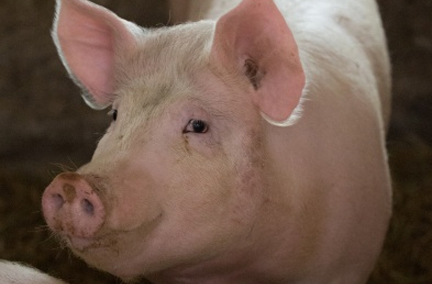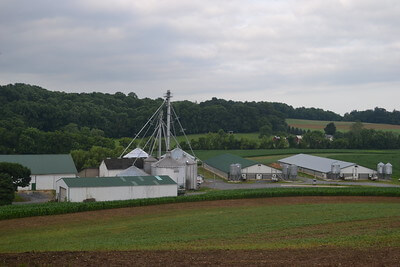
SHIC, launched by the National Pork Board in 2015 solely with Pork Checkoff funding, continues to focus efforts on prevention, preparedness, and response to novel and emerging swine disease for the benefit of US swine health. As a conduit of information and research, SHIC encourages sharing of its publications and research. Forward, reprint, and quote SHIC material freely. SHIC is funded by America’s pork producers to fulfill its mission to protect and enhance the health of the US swine herd. For more information, visit http://www.swinehealth.org or contact Dr. Sundberg at [email protected].

US swine herd health is vulnerable to emerging domestic and international swine diseases, as the introduction of porcine epidemic diarrhea virus in 2013 clearly revealed. African swine fever, as well as other foreign animal diseases, threaten today. Checkoff funding has given the Swine Health Information Center the opportunity to focus on emerging swine disease risk. SHIC’s 2022 Progress Report, presented to and accepted by the board of directors of the National Pork Board on December 15, 2022, details steps taken in 2022 to achieve the mission of safeguarding the health of the US swine herd.
SHIC’s 2022 Progress Report details how analysis of swine health data during the first six months of the year prompted revision of its 2022 plan of work mid-year to address a vulnerability identified in nursery, finishing, and transport biosecurity. During their June meeting, the SHIC Board of Directors approved the formation of the Wean-to-Harvest Biosecurity Program. Industry-wide task forces helped set research priorities and a national and international call for research proposals to address them was advertised, with work expected to begin this winter. The actions illustrate SHIC’s ability to change direction in quick response to an identified producer need.
SHIC’s international monitoring program alerted it to an outbreak of Japanese encephalitis virus in Australia early in 2022. Australia’s pork producers have lost an estimated 6% to 10% of their production. SHIC has funded a comprehensive literature review focused on the unique serotype of JEV that caused the outbreak and an updated US risk assessment of entry and establishment of the virus. In addition, a SHIC-sponsored seminar brought together Australia’s producers, animal health researchers, and animal and public health regulatory agencies with the USDA, CDC, and US researchers to see what lessons can be learned from the Australian experience to help prevent JEV from getting to the US or, if it does get in, to be prepared to respond quickly.
SHIC is guided by a board of directors made up of pork producers and swine veterinarians who expect timely, practical, and actionable outcomes. Unique among all other meat commodities in the US, or around the world, the US pork industry had the foresight to look for things coming at it instead of waiting and reacting to what happens.

In late November 2021, outbreaks of Actinobacillus pleuropneumoniae serotype 15 in the upper Midwest were detected. The outbreaks were unusual in several respects, including 1) the relative rarity of APP15 isolation in the US, 2) the unusually high mortality for this strain, and 3) the epidemiologic evidence of lateral transmission between systems within a narrow geographic radius.
Following the outbreak, SHIC funded work with Dr. Derald Holtkamp of Iowa State University to lead a team evaluating possible sources of APP15 transmission between company-owned sites with outbreaks. In parallel, SHIC funded work with Drs. Alyona Michael and Marcelo Almeida, ISU Veterinary Diagnostic Lab, to rule out endemic maintenance of APP15 in sow herds that had supplied finishers impacted in 2021 and to characterize post-outbreak ecology for identification of risk factors for lateral transmission. Their interim report reveals several key findings.
While APP has been in the US for a long time, it was not a problem that herd veterinarians regularly faced due to infrequency of APP-associated disease. This was, in part, due to a significant effort by swine genetics companies in the 1990s to successfully eliminate APP from their farms. The rest of the pork production industry followed suit. When APP outbreaks did occur, they were not large scale nor with the high level of mortality seen in the November 2021 outbreak in Iowa. In 2021, however, when more than usual cases of APP were seen at the ISU VDL, staff talked with herd veterinarians and learned that cases were from a certain geographic area and had high mortality reaching 50% in some instances.
In response, research investigating the shedding patterns of APP15 in nasal swabs, tonsils, and oral fluids was pursued to help future diagnostic investigations. The team also looked for unique characteristics about this specific serotype/strain compared to other historical APP isolates.
As a first objective, serum was collected from sows for serological evaluation. Of the 16 farms tested, 4 were positive for APP antibodies. In the positive farms, antibodies were detected by ELISA against APP serotypes 3, 6, 8, and 15. In the majority of farms that tested negative for APP antibodies (12/16), it was assumed that pigs supplied to farms that later had outbreaks were APP-negative at placement. This provides evidence for lateral APP15 introduction for finisher sites receiving pigs from serologically negative sow farms. For farms testing positive for the serogroup APP15, the next step is to sequence isolates from that farm.
Sows positive for antibodies against APP serotypes 3, 6, 8, and 15 require further testing to identify which sows are positive only for APP15. This will be accomplished by collecting tonsil scrapings from serologically positive sow farms to attempt bacterial isolation, PCR serotyping, and whole-genome sequencing. Whole-genome sequencing will be essential to match an APP15 isolate from sow farms to the strain circulating in the outbreak, as not all APP15 isolates are the same.
As a second objective, an affected site was sampled and tested post outbreak to understand shedding dynamics and environmental persistence. On a site with three barns, 67 pigs identified by ear tags were tested weekly over a six-week period. The goal was to determine if the same pigs were continually or intermittently shedding over that period of time.
In the first sampling, 50% of the pigs were positive in both nasal swabs and tonsil scrapings. Incomplete agreement between those two sample types occurred and over time, the percentage of positive results increased in tonsil scrapings while nasal swabs decreased. Researchers concluded tonsil scrapings are more sensitive samples than nasal swabs as time passes after outbreaks.
In all three barns, oral fluids sampling took place in every pen with animals. In the second and third samplings, over 50% of samples were positive. This was surprising, as oral fluids have traditionally been considered a poor sample type for APP diagnostics. This may be associated with differing dynamics of experimental vs field APP challenge and transmission. Another key finding was that oral fluids were successfully used for detection of bacteria by PCR.
In the end, researchers were able to detect APP up to the last sampling point of the study in tonsil scrapings and oral fluids, at lower detection rates, nine weeks after the reported outbreak. This is significantly longer than literature reports of seven days post infection.
Regarding environmental sampling conducted as part of the study, at the first sampling point only the rendering box and the office door handle tested positive for APP by PCR. All samples tested negative for APP by PCR on the second collection. The rendering box was positive again at the third time point and the door handles of all three barns on site also tested positive. The office door handle, and the floor by the entrance door of two barns, tested as suspect. At the last sampling, 11 samples tested positive for APP by PCR at the rendering box, feed plates, and floor samples collected in front of feeders in all barns as well as floor by the entrance door of one barn.

A review of technologies that remove or/and inactivate airborne pathogens found that air filtration, solely consisting of fibrous filters, is currently the only established and implemented system on swine farms. Thus, SHIC funded a project with the goal of identifying other industrially and medically implementable technologies – electrostatic precipitators and ultraviolet-C systems, both in-duct and upper room – that could have a role in livestock management as they are scalable and effective. The review, conducted by a team led by Dr. Montserrat Torremorell of the University of Minnesota, includes examining these and other aerosol biocontainment options for their use on swine farms.
Overall, the purpose of the aerosol biocontainment review is to help in the decision-making process to prevent the spread of infectious bioaerosols capable of causing disease outbreaks with significant economic consequences. Aerosol biocontainment addresses airborne pathogens which are the most difficult to control and, in modern livestock production, the most difficult to contain. For swine raised in confinement and in controlled ventilated environments where exhaust fans help transport particles from inside to outside of the facility, this is particularly true.
Emerging technologies, consisting of more recently developed systems at the laboratory or bench scale, have not been tested at the scale, such as building size and flow rates, required for agricultural biosecurity. Consequently, these new options are several developmental steps away from direct implementation. Examples of emerging technologies include microwave, bipolar and unipolar ionization, non-thermal plasma, photocatalytic, ozone and chemical disinfection.
Beyond air filtration and emerging technologies, the review discovered protocols and practices that could currently be ready for use at the farm level including wind breaks, covering of fans, movement of infected animals to other sites, depopulation, and reduced ventilation. Conceptually, these protocols and practices could be employed in the face of a disease outbreak, but their direct impact on reducing the emission airborne pathogens needs to be evaluated and quantified.
In the forthcoming publication of this project, Dr. Torremorell’s team describes the nature of the technologies as well as discusses testing parameters and future steps for considering existing and emerging technologies for livestock production.

There is still time to provide input for SHIC’s 2023 Plan of Work which will guide activities in 2023. Input may include topic areas, research priorities, and identified industry needs in which SHIC should focus efforts, such as an emerging swine disease or an emerging swine health issue. Rather than restricting efforts of the Center, the Plan of Work provides a roadmap for the next year but remains flexible, allowing SHIC to react to issues of the industry as they occur in real-time while staying true to the organization’s mission.
Suggestions for the 2023 SHIC Plan of Work can be directed to SHIC Executive Director Dr. Paul Sundberg at [email protected] or 515-451-6652 or SHIC Associate Director Dr. Megan Niederwerder at [email protected] or 785-452-8270. Additional input and ideas are welcome anytime throughout the year to inform newly identified needs which may necessitate adapting or adjusting the Plan of Work. The 2022 Plan of Work, as published in January 2022, can be reviewed here.

This month’s Domestic Swine Disease Monitoring Report includes information about the increased RT-PCR detection of PRRSV in adult/sow farm age category, moreover, the emergence of Lineage 1C RFLP 1-2-4 with double detection in 2022 compared with 2021. In addition, the SDRS detected this strain in Iowa, Missouri, Minnesota, Indiana, Illinois, and Ohio. Influenza A virus sharply decreased RT-PCR positive detection in all age categories. Also, PEDV and PDCoV RT-PCR detection had a moderate increase in the percentage of positive submissions, mainly in the wean-to-market age category, followed by an increased number of confirmed tissue diagnoses of these enteric coronaviruses. In the podcast, the SDRS hosts talk with Dr. Clayton Johnson, partner and veterinarian at Carthage Veterinary Services, about the missing puzzle in PRRSV controlling, PRRSV Lineage 1C variant strain scenario, Lineage 1C RFLP 1-2-4 emergence, and PEDV elimination programs.

The January International Disease Monitoring Report contains a review of 2022. Over 100 events of interest for the swine industry that described the presence of a new agent in a country or region or a significant update on the epidemiology of the disease already present in a region were identified and presented in these monthly reports. Even though ASF remains the main disease, regarding the frequency of events and the geographical spread, almost 25% of those were related to other agents of concern. Jointly, these events involved over 310,000 pigs directly affected by the outbreaks (this number doesn’t include any population of animals culled to limit the spread of the diseases or secondary outbreaks reported afterward).
Copyright 2025 | Swinehealth.org | Website by Heartland Marketing Group